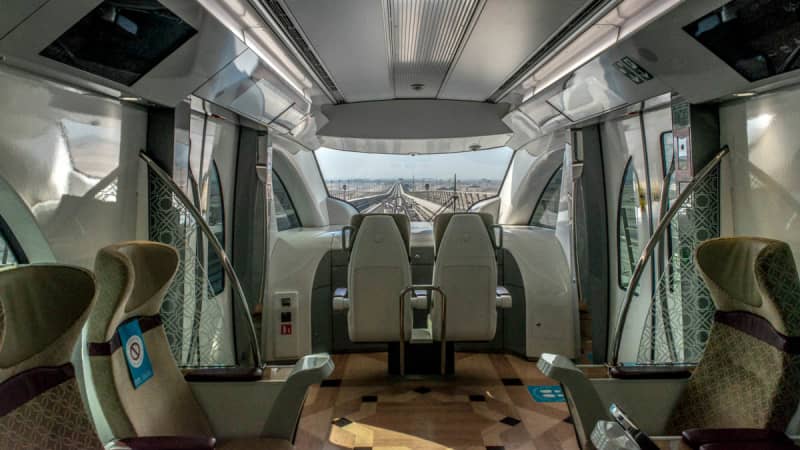(CNN) — It’s fast. It’s driverless. It has a Gold Class for premium passengers. And it’s one of the most advanced metro train systems ever built.
This is the Doha Metro, a gleaming transportation system that will carry fans to their destination in next year’s soccer World Cup and, it’s hoped, will go on to revolutionize transport in Qatar.
Constructed mostly underground and across the Qatari capital and its suburbs, the network has been operational since 2019, providing a reliable transportation alternative in a rapidly expanding city where residents have long relied on cars and traffic is frequently gridlocked.
Phase one of the project saw the creation of 37 stations, with three lines — Red, Green and Gold — running along a 76-kilometer (47-mile) network.
The fully automated, 60-meter-long trains have a 416-passenger capacity and are divided into three sections: Standard, Family (for lone females and males or females commuting with children aged 11 or younger) and Gold (Goldclub Travel Card holders) class.
Clean and spacious, the trains can cruise at up to 100 kilometers per hour (60 mph) and are fully equipped with CCTV and public Wi-Fi systems. They even have USB ports so that Gold class travelers can charge mobile phones and tablets while in transit.
Merging past and future
The stations were all designed to represent a vision of both modernization and preservation, fusing traditional features of regional architecture with a contemporary approach.
“It was important that the design would relate to its context, to the city of Doha and to Qatar,” Ben van Berkel, co-founder of UNStudio, a Dutch architecture firm that joined forces with the Qatar Rail Architecture Department to create the stations, tells CNN Travel.
“We wanted to merge the past and the future of Qatar in one gesture, so we drew inspiration from various traditional Qatari architectural elements — particularly the arch — and adjusted this to create what we refer to as ‘vaulted spaces,'” he says.
“So, while the exteriors somewhat reference the monolithic strength of old Qatari architecture, the interior spaces create an effect of light, movement and fluidity.”
Design and planning objectives

The metro is a crucial part of Qatar’s plans for hosting the soccer World Cup 2022.
Dimitris Sideridis
While curved forms and illumination were key design elements, maintaining a clear architectural identity was also essential.
Van Berkel said one of the main challenges with a brand new project of this scale was “to create a design which enables both coherence and individuality.”
“On the one hand, you have to create recognition points across a whole city, while on the other, each individual station has to have its own scale, identity and respond to its specific context,” he explains.
The architects tackled this through the use of recurring elements and materials, including solid sandstone exteriors and striking interiors with a mother-of-pearl iridescence — a nod to Qatar’s long history as a major pearl-diving and trading hub.
By devising a standard but adaptive system it also became possible to use a variety of configurations, each of which respond to the specific requirements and sizes of the individual stations.
“The scale of the metro network in Doha required careful planning in order to comply with a strict time schedule and achieve minimum disruption to the existing infrastructure,” Van Berkel says. “For this reason, flexibility became a design and planning objective on all levels.”
Major artery
At the heart of it all is Msheireb Station, the largest in the network as well as its interchange serving as a hub for all three lines running through it.
Vast and sleek, the impressive station features a total of four main levels and has a depth of approximately 40 meters. Past its illuminated entrance, triangular arched forms adorned with hexagon-shaped pearlescent tiles lend a futuristic look that extends all the way to the platform levels.
The station’s rich interior spaces also offer an array of commercial shops, while the modest exterior is dotted with bicycle racks.
Outside, commuters and passersby can also marvel at a mural by Doha-based artist Abdulaziz Yousef Ahmed titled “Family Reunion” — one of the several pieces of art on display along the network, which include a replica of the Greek statue of “Charioteer of Delphi” that World Cup spectators will come across upon arrival at Hamad International Airport metro station.
The world’s biggest soccer event is still more than a year away, but preparations are already underway, with the new subterranean rail network at their core.
Inside the Sport City station, large posters of blue-and-white footballs emblazoned with arrows point towards the direction of the nearby Khalifa International Stadium, one of the venues that will host the FIFA World Cup Qatar 2022.
Eco legacy
Organizers expect more than one million people to arrive in Doha during the first World Cup to be held in the Middle East and the Arab world — and the Metro system was designed to be its transportation pillar.
The system directly links Doha’s Hamad International Airport with five of the eight stadiums hosting Qatar 22 matches, with the remaining sites of the compact event being accessible via a mixture of rail and bus options.
Organizers say the Doha Metro will — in concert with bus and tram routes — shuttle fans between their hotels, the stadiums and the city’s various tourist attractions.
Looking beyond the World Cup, officials see the expanding Doha Metro as a key infrastructural component of the Qatar National Vision 2030 — the gas-rich country’s development plan to diversify its economy — that will benefit future generations in the years to follow the football tournament final on December 18, 2022.
“The legacy that eco-transportation will leave is something that will be felt by everyone in Qatar long after the World Cup,” says Thani Al Zarraa, mobility director for the event’s Supreme Committee for Delivery & Legacy.



